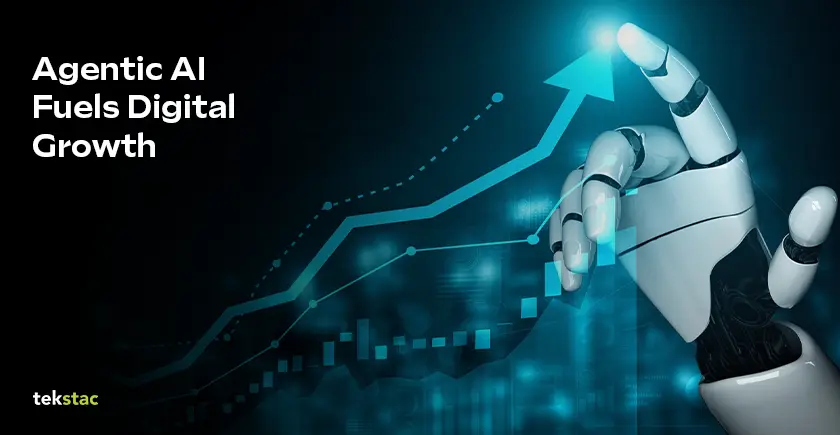Powering the Future: How Agentic AI is Transforming Businesses
April 15, 2025

Based on PwC India’s Report on “Powering Automation with Agents”
The Rise of Agentic AI: A New Era for Businesses
Automation has come a long way- from simple task automation to AI-driven intelligent systems. Now, we are entering a new era: Agentic Powered Automation (APA), a revolutionary approach that combines Generative AI (GenAI) with automation tools to create self-learning, adaptive business processes. A recent report by PwC India sheds light on how APA is reshaping industries, enhancing efficiency, and paving the way for a smarter, AI-driven future.
Understanding Agentic Powered Automation (APA)
At its core, APA integrates AI-powered agents (the ‘brain’) with intelligent automation tools (the ‘hands’) to create dynamic, responsive business workflows. These AI agents don’t just follow predefined rules, they understand context, make decisions, and collaborate with other agents to execute complex tasks with minimal human intervention.
This shift from traditional automation to AI-driven decision-making marks a significant transformation in how businesses operate. Instead of static workflows, APA enables real-time adaptability, making businesses more resilient and efficient.
The Role of Intelligent Agents in Business Transformation
Agentic automation is rapidly being adopted across industries. The PwC report highlights several key areas where APA is making a significant impact:
Top Agentic AI Use Cases Across Industries
1. Finance & Accounting
- Automated invoice processing to reduce human errors and increase efficiency.
- AI-powered cash flow management, providing real-time insights for financial planning.
- Smart expense reconciliation to streamline approvals and detect discrepancies.
2. Supply Chain & Logistics
- Demand forecasting agents analyze historical trends to improve inventory management.
- Supplier onboarding automation simplifies contract verification and reduces processing time.
- Returns processing automation ensures faster refunds and seamless restocking.
3. Human Resources & Talent Acquisition
- AI-driven talent search agents source, screen, and shortlist candidates efficiently.
- Employee experience bots provide instant responses to HR-related queries.
- Automated compliance and payroll management ensures accuracy and efficiency.
4. Customer Service & Marketing
- Conversational AI agents provide personalized customer support 24/7.
- Brand monitoring tools track customer sentiment and flag potential risks.
- SEO optimization agents analyze website performance and suggest improvements.
These examples illustrate how APA is enhancing business operations by reducing manual intervention, minimizing errors, and accelerating decision-making processes.
The Human-AI Partnership: Enhancing, Not Replacing
One of the biggest concerns surrounding automation is job displacement. However, APA does not aim to replace human workers; rather, it empowers them by taking over repetitive, time-consuming tasks. This allows professionals to focus on more strategic, creative, and decision-making roles.
For instance:
Financial analysts can leverage AI-generated insights to make more informed investment decisions.
- HR professionals can focus on talent development rather than spending time on administrative tasks.
- Marketing teams can use AI-driven analytics to craft more targeted and effective campaigns.
Thus, APA fosters a symbiotic relationship between humans and AI, where technology amplifies human capabilities instead of replacing them.
Challenges and Ethical Considerations
With great power comes great responsibility. As organizations integrate APA into their ecosystems, they must address key challenges:
- Ethical AI Governance – Ensuring AI agents make fair and unbiased decisions.
- Data Privacy & Security – Protecting sensitive information from misuse.
- Transparency & Accountability – Keeping AI operations interpretable and auditable.
- Regulatory Compliance – Aligning automation strategies with global and local laws.
Companies must establish clear AI governance frameworks to mitigate risks and build trust among employees, customers, and stakeholders.
Looking Ahead: The Future of Agentic Automation
PwC’s report highlights that the future of business lies in seamlessly blending human expertise with AI-powered automation. Organizations that adopt APA today will gain a competitive edge by:
- Accelerating productivity through smart automation.
- Reducing operational costs with minimal human intervention.
- Enhancing customer and employee experiences through intelligent interactions.
As the world moves toward an AI-driven future, embracing APA is no longer an option, it’s a necessity. Businesses that integrate AI-driven agents into their workflows will unlock new growth opportunities, drive efficiency, and reshape industries for years to come.
Final Thoughts
Agentic Powered Automation is more than just a technological advancement; it’s a paradigm shift in how businesses operate. As organizations prepare for this transformation, they must adopt AI responsibly, ensuring that technology serves as an enabler of human potential rather than a replacement.
The question is no longer whether businesses should embrace Agentic Powered Automation (APA) but how quickly they can adapt to stay ahead in an increasingly competitive landscape. The future of work is here, are we ready to embrace it?





